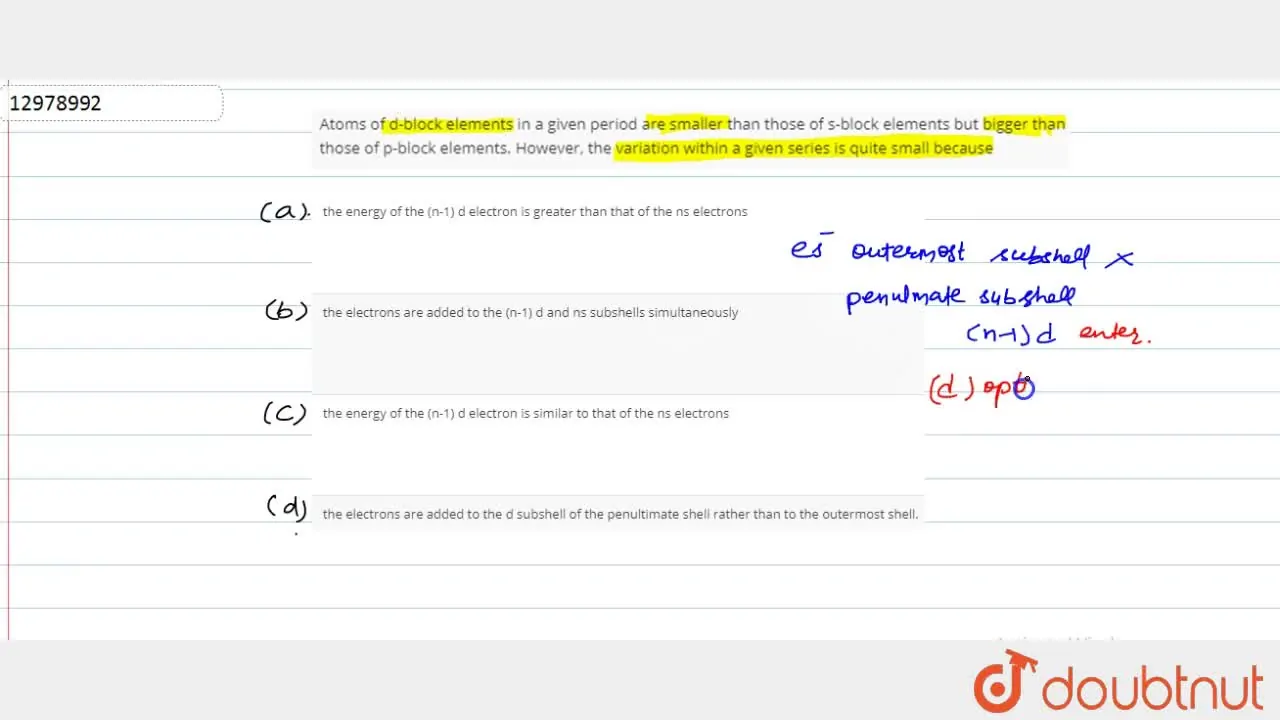Atoms of d-block elements in a given period are smaller than those of s-block elements but bigger than those of p-block elements. However, the variation within a given series is quite small because
the energy of the (n-1) d electron is greater than that of the ns electrons
the electrons are added to the (n-1) d and ns subshells simultaneously
the energy of the (n-1) d electron is similar to that of the ns electrons
the electrons are added to the d subshell of the penultimate shell rather than to the outermost shell.
The correct Answer is:D
There is a gradual decrease in atomic radius across a row of d-block elements. On passing from left to right, additional positive charges are placed on the nucles and corresponding electrons are added to the (n-1) d shushell. As the electrons in the (n-1) subshell shied the ns electrons and also themselves form the nuclear charges incompletely (d electrons have poor shielding effect), effective nuclear charge felt by them increases and hence a contraction in size occurs. However, it is noteworthy to note that shieldig of the outermost ns electrons (s) by (n-1) d electons (s) is more efficient than the shielding of an ns electron by another ns electron (or that of an np electron by another np electron by another ns electron (or that of an np electron by another np electron). Consequently the decrease in atomic radius form Na to CI is much greatyer than that from Sc to Cu. Thus, the elements which occur immediately after the d-block elements are smaller than expected form simple extrapolation form the group elements. For example, AI and Ga have similar atomic radii. The atomic radii of the elements of the elements of a given d-block series decrease with increase in atomic number but this decrease becomes small after midway because of the increase in the number of (n-1) d electrons. Their cumulative effect tends to nullify the effect of increased nuclear charge. Thus, in the first d-block series, the atomic radius decreases gradully form Sc to Cr but form Cr Cu, it is almost the same. Similar behaviour is observed in the other series of d-block elements.
Related Playlists
- BOOK - R SHARMACHAPTER - THE D AND F BLOCK ELEMENTSEXERCISE - Follow-up Test 311videos
THE D AND F BLOCK ELEMENTS
- BOOK - R SHARMACHAPTER - THE D AND F BLOCK ELEMENTSEXERCISE - Follow-up Test 418videos
THE D AND F BLOCK ELEMENTS
- BOOK - R SHARMACHAPTER - THE D AND F BLOCK ELEMENTSEXERCISE - Archives54videos
THE D AND F BLOCK ELEMENTS
- BOOK - R SHARMACHAPTER - SURFACE CHEMISTRYEXERCISE - Archives18videos
SURFACE CHEMISTRY
- BOOK - R SHARMACHAPTER - THE P BLOCK ELEMENTSEXERCISE - Archieves62videos
THE P BLOCK ELEMENTS
Similar Questions
In case of d-block elements
View SolutionIn case of d-block elements
View SolutionAtoms of the transition elements are smaller than those of the s-block elements, because:
View SolutionAtoms of the transition element are smaller than those of the s-block elements, because :
View SolutionNumber of s-block elements are:
View SolutionNumber of s-block elements are:
View Solutions-block elements are placed in
View SolutionWhat are s−block elements?
View SolutionWhat are d-block elements? Why are they called transition metals?
View SolutionIdentify d-block element ?
View Solution


